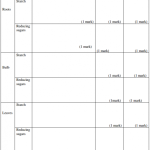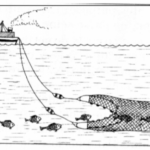KNEC KCSE Geography Paper 2 Question Paper / 2016 KCSE 4MCK Joint Exam
2016 KCSE 4MCK Joint Exam
Geography Paper 2
SECTION A (25 Marks)
a) What is practical Geography? (2 marks)
b) Name three areas of study in practical Geography. (3 marks)
5 marks
a) Give one modern method of fishing used in Kenya. (1 mark)
b) Describe how a basket is used in fishing. (4 marks)
5 marks
a) State two physical conditions favoring oil farming in Nigeria. (2 marks)
b) State three uses of palm oil tree. (3 marks)
5 marks
a) Name two examples of navigable rivers in Africa. (2 marks)
b) State three reasons why there are few railway links in Africa. (3 marks)
5 marks
Use the map below to answer question that follow:
(i) What is urbanization? (1 mark)
(ii) Name the urban centers marked P,Q,R, and S. (4 marks)
5 marks
a) (i) Apart from geothermal power, name three other renewable sources of energy in
Kenya. (3 marks)
(ii)State four factors limiting the exploitation of geothermal power in Kenya. (4 marks)
b) (i) Give three factors considered when setting up an hydro-electric power generation
plant. (3 marks)
(ii) List three advantages of electricity over other sources of energy. (3 marks)
c) (i) What is energy crisis? (2 marks)
(ii) Give three causes of energy crisis. (3 marks)
d) Explain four effects of energy crisis to the economy of a developing country. (8 marks)
25 marks
SECTION B (75 Marks)
The data below shows cattle population in major countries of the world by percentage of
the world total.
| Country India U.S.A Denmark Brazil China Argentina Australia France Ethiopia Others |
% 15 10 10 8 5 5 4 4 2 37 |
a) i) Draw a divided rectangle 10cm long to represent the cattle population in various
countries given in the data above. (9 marks)
ii) State two advantages of using divided rectangles to represent geographical data.
(2 marks)
b) i) State four physical factors which favor dairy farming in Kenya. (4 marks)
ii) Apart from Fresian cows, name any other two dairy cattle kept in Kenya. (2 marks)
iii) Explain four differences between Dairy farming in Kenya and Denmark. (8 marks)
25 marks
a) (i) What is an environmental hazard? (2 marks)
(ii) Name four environmental hazards in Kenya apart from pollution. (4 marks)
b)Discuss three reasons why environmental management and conservation is essential. (6 marks)
c) Students from Chuluni Secondary school conducted a field study on the causes of noise
pollution in Nairobi.
i) Formulate four alternative hypothesis for their study. (4 marks)
ii) State three effects of noise pollution they would have identified. (3 marks)
d) Explain three measures that can be undertaken to curb pollution. (6 marks)
25 marks
a) (i) What is industrial inertia? (2 marks)
(ii) State four aims of decentralization. (4 marks)
b) (i) What are cottage industries. (2 marks)
(ii) State any four characteristics of cottage industries. (4 marks)
(iii) Name any other three cottage industries in Kenya apart from jua kali industries.
(8 marks)
c) (i) Explain four contributions of jua kali industries in Kenya. (8 marks)
d) Name two major car manufacturing zones in Japan. (2 marks)
25 marks
a) (i) What is forestry? (2 marks)
(ii) Tabulate the difference between natural and planted forests. (4 marks)
b) Describe how the following factors influence types and distribution of forests.
i) Temperature (2 marks)
ii) Aspect (2 marks)
iii) Precipitation (2 marks)
c) (i) State four importance of forest products. (4 marks)
(ii) Name any two tropical hardwood forest in Kenya. (2 marks)
(iv) Name any two forests along the Kenyan Coast. (2 marks)
d)Outline five differences between forestry in Kenya and Canada. (5 marks)
25 marks






